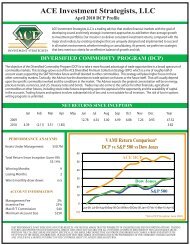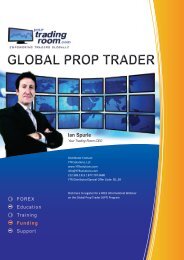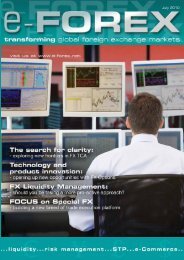You also want an ePaper? Increase the reach of your titles
YUMPU automatically turns print PDFs into web optimized ePapers that Google loves.
LEADER<br />
Brave New World<br />
So what is really happening in the world of OTC<br />
derivatives? The trends in the industry are quite<br />
readily apparent:<br />
• A huge scaling back in the structured products<br />
business as gun shy investors lick their wounds<br />
and park their money in perceived safer havens<br />
• The last 18 months taught us that even simple<br />
derivatives can be<strong>com</strong>e difficult to price where<br />
markets are illiquid.<br />
• A huge increase in the difficulty of pricing even<br />
the simplest derivatives as never before<br />
considered systemic liquidity factors drive the<br />
short end of yield curves<br />
• An intense focus on “B-School” principles:<br />
operational risk, operational leverage, credit<br />
exposure, funding exposure, etc.<br />
• A move by an increasing number of dealers to<br />
utilise non-traditional derivatives distribution<br />
channels such as regional lending networks<br />
• A refocusing of the business around core<br />
hedging related activities<br />
• Competition through better client service,<br />
rather than through rapid innovation of<br />
<strong>com</strong>plex structures<br />
• A major shift in technology spending from the<br />
development of sophisticated multi factor<br />
pricing and risk management models to the<br />
building of integrated front office solutions<br />
which address the new reality<br />
The OTC derivatives business has changed<br />
dramatically over the past 18 months; those firms<br />
who have adapted or are adapting rapidly and<br />
effectively to these changes are, while perhaps not<br />
thriving, surviving and seeing a potentially bright<br />
future. Those who have not adapted successfully are<br />
struggling. Critical to adapting to this new reality is<br />
technology and systems tailored to that reality.<br />
The new technology of <strong>com</strong>petition<br />
Virtually every derivatives dealer we speak with across<br />
the world is, to a greater or lesser extent, trying to adapt<br />
or augment their technological capabilities to facilitate<br />
<strong>com</strong>petition and efficiency within the rapidly changing<br />
landscape of the derivatives market. The simple reality<br />
is that an overwhelming percentage of the money spent<br />
on system development over the past decade has gone<br />
towards increasing the trading desk’s ability to price and<br />
warehouse increasingly <strong>com</strong>plex risk.<br />
Traditionally, dealer IT and Quant departments are<br />
extremely good at delivering <strong>com</strong>plex models and risk<br />
management technology to the trading desk; they<br />
20 | january 2010 e-FOREX<br />
have been less successful at delivering the tools<br />
necessary for the front office to <strong>com</strong>pete effectively<br />
and operate efficiently in the vanilla derivatives space.<br />
This is partly due to lack of experience and partly due<br />
to an almost obsessive focus on model development.<br />
As the derivatives industry and the nature of dealer<br />
<strong>com</strong>petition be<strong>com</strong>e centred on client service,<br />
technology that supports this service, both indirectly<br />
and directly, is be<strong>com</strong>ing the focus of both the IT<br />
departments and the front offices of dealers across the<br />
globe.<br />
Our discussions around technology needs with almost<br />
every dealer we speak to revolve around the same<br />
themes:<br />
• The ability to deliver accurate option pricing<br />
and high quality supporting documentation and<br />
research to clients faster than the <strong>com</strong>petition<br />
can manage.<br />
• The ability to efficiently provide peripheral<br />
services to clients, such as ad hoc risk analysis.<br />
• Tools that support a more efficient work-flow<br />
between sales and trading.<br />
• The reduction of operational risk through<br />
integration of front and back office systems.<br />
• The ability to pro-actively sell to clients based<br />
on their exposures and needs rather than purely<br />
based on the desk’s trading axes through better<br />
tracking of the clients’ activities.<br />
• Foolproof, easy to use pricing and analysis tools<br />
to enable distribution channels with less<br />
derivatives expertise to effectively sell.<br />
• “Economies of scale” in the derivatives<br />
distribution process through better sharing and<br />
archiving of information.<br />
There is almost universal recognition among derivatives<br />
dealers of the need for scalable, integrated front office<br />
and distribution software to address these issues. Dealers<br />
are currently facing the age old dilemma of technology<br />
procurement: build or buy. Fortunately, a few vendors<br />
have emerged over the last few years that are focusing on<br />
building these technologies. Those dealers who have<br />
embraced the changing landscape of derivatives<br />
<strong>com</strong>petition by addressing the need for new technologies<br />
are seeing opportunities in the FX derivatives market<br />
that have not existed in years; this edge, coupled with the<br />
decreased dominance of the franchise players, has created<br />
enormous growth potential for the small to midsize<br />
derivatives dealer. This has created more business growth<br />
potential for a broader spectrum of derivative experts. As<br />
long as risk is managed, accurate valuations are adhered<br />
to and client service is exemplary this market will<br />
continue to be robust.










